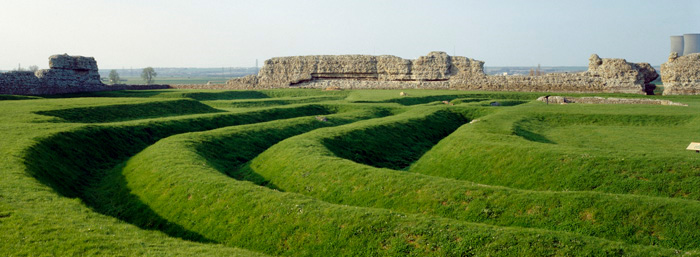This is what we found. You would have thought we would have spotted this in the last ten years.
Apparently we had managed to miss it.
This is Richborough Roman Fort and Amphitheater. It sits proudly in the East Kent marshes and was witness to both the beginning and the end of the Roman rule in Britain.
Known as Rutupiae, Richborough is the original gateway to Britain, long before Dover. It is here that the 4 invading legions under Aulus Plautius assembled after landing in Britain during the Claudian invasion of A.D.43. Watling Street leaves by its West Gate and leads straight to Canterbury (where it still exists) and London and North West to Chester.
It is located about 1 mile to the north of Sandwich, one of the historic towns on the River Stour and guarded the Wansum Channel when the sea flowed around the cliff on which the Castle stands. The sea has long since receded and the coast line moved.
The pictures above do not adequately capture the scale of this place.
It is huge.
I'll give you an idea of the scale. That's me below. Falling off something.
Richborough was used during the length of the Roman occupation, from the invasion of A.D. 43 until the end of the Roman rule in A.D. 410.
It developed from an early fortification to a civilian town and port before returning to military use with the building of a Saxon Shore fort as a protection against Saxon raiders. It formed a line of forts with the ones at Reculver (Regulbium), Dover (Dubrae), Lympne (Portus Lemanis) and Pevensey (Anderitum).
There used to be a small town at the foot of the fortress called Stonar which was destroyed in a great flood in 1365 A.D.
It has been suggested that the amphitheatre was constructed in the late
3rd century. It provided the inhabitants of the town with a place for
entertainments such as wild animal hunts and gladiatorial combat.
Romano-British amphitheatres were usually not elaborate structures.
Excavations in 1849 and recent geophysical survey of the area indicate an arena surrounded by sloping banks of mixed clay and mortar, which would probably have been used as a support for wooden seats.
Today the amphitheatre survives as an elliptical hollow which represents the central arena.
It is surrounded by a bank 12 metres (39 feet) wide and rising to a height of about 2 metres (7 feet). At the narrow ends of the elliptical plan there are two obvious entrances, while on the north-west and south-east sides there are indications of additional entrances or architectural features, possibly towers.
It is really humbling to be able to walk through a site like this, look at the stone work and touch pieces of masonry that were held by men who lived 2000 years before your birth.
It is also slightly daunting to think that each layer was built by hand, each stone was gathered and laid. It makes you re-evaluate the term 'hard graft'.
We spent an hour or so here wandering around and reading up on the history of this amazing place that is off the beaten track.
It makes you wonder what else is out there, on your back doorstep that you don't know about.
*some images and information courtesy of English Heritage, Harris, S 2001. 'Richborough and Reculver', London: English Heritage and www.open-sandwich.co.uk.



No comments:
Post a Comment